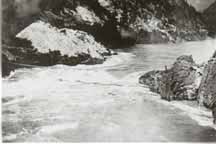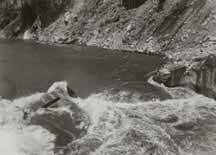During the years 1913, 1914 and 1915 the Federal and Provincial Governments endeavoured to restore the original conditions as far as possible without resorting to sub-aqueous work. By end of 1915, approximately sixty thousand cubic yards of rock from the February 1914 slide had been removed by excavation & blasting and mainly dumped into the river downstream of the rapids and partially stored on adjacent riverbanks. Subsequent surveys by Canadian engineers indicated that the river hydraulics (the water surface drop) at Hell’s Gate remained basically unchanged at all river levels, with the "rapids" section moving longitudinally downstream as the river discharge increased. Measurements showed the overall water surface drop to be about 9 feet regardless of river level. In other words, the overall surface drop would measure about 9 feet at low water, at high water and at river stages in-between. Observations indicated however that a surface drop of 9 feet, over a relatively short distance, combined with high water velocities and high turbulence were still an obstacle for salmon migrating up-river.


Click on images to enlarge